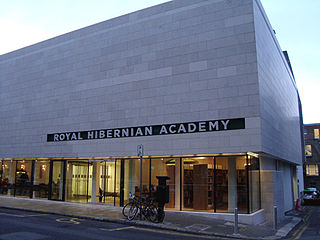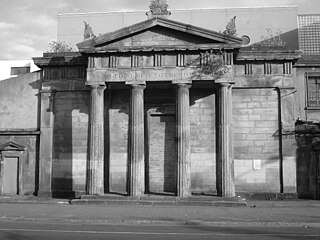Related Research Articles

The Royal Hibernian Academy (RHA) is an artist-based and artist-oriented institution in Ireland, founded in Dublin in 1823. Like many other Irish institutions, such as the RIA, the academy retained the word "Royal" after most of Ireland became independent as the Irish Free State in December 1922.

George Petrie was an Irish painter, musician, antiquarian and archaeologist of the Victorian era who was instrumental in building the collections of the Royal Irish Academy and National Museum of Ireland.

Island Bridge, formerly Sarah or Sarah's Bridge, is a road bridge spanning the River Liffey, in Dublin, Ireland which joins the South Circular Road to Conyngham Road at the Phoenix Park.
Events from the year 1823 in Ireland.

Cobwebs to Catch Flies (1783) is a children's book by Ellenor Fenn, originally anonymous, but later editions were advertised as being by Mrs Teachwell or "Mrs Lovechild". It was a reading primer and was one of the first books to differentiate between reading age groups, and which was widely used until the 1890s.

St. James' Church is a former Church of Ireland church in James's Street, Dublin, Ireland. Established in 1707, the corresponding parish, which was separated from that of nearby St. Catherine's, was established in 1710. There had been a shrine dedicated to St. James at nearby St. James's Gate, a stopping-off point for pilgrims, since medieval times. It has been proposed that the current church is near to the site of a church to St. James of Compostella which is first referred to in the mid-13th century.

St. Nicholas Within is a former Church of Ireland parish church in Dublin city, Ireland. It was located at the corner of Nicholas St. and Christchurch Place, where part of its entrance may be seen next to the Peace Park. The term may also refer to the civil parish in the barony of Dublin City which was one of nine and a half baronies in the old County Dublin.

The Richmond General Penitentiary was a prison established in 1820 in Grangegorman, Dublin, Ireland as an alternative to transportation. It was part of an experiment into a penitentiary system which also involved Millbank Penitentiary, London. Richmond and Millbank penitentiaries were the first prisons in the United Kingdom of Great Britain and Ireland to specialise in reform rather than punishment. The building was designed by the architect Francis Johnston and decorated by George Stapleton. The building ceased to be a penitentiary in 1831, and later became part of the Richmond Asylum.

The Old Church of St. George, commonly called "Little George's" in Hill Street Parish of St. Mary, Dublin was built in 1668 by the Eccles family for their workmen and also as a chapel-of-ease to a nearby St. Mary's Church. However, that St. Mary's Church was not St. Mary's Church, Dublin as that church’s foundation stone was laid in 1700, and it was not St. Mary's Abbey, Dublin as that was dissolved in 1539. Therefore St George's Church, Hill Street, may have been a Chapel-of-Ease to St. Michan's Church in Church Street. The main body of the church, with the exception of the tower, was demolished in 1894.
Thomas Fletcher was an 18th-century Anglican bishop in Ireland.
Charles Jackson was an 18th-century Anglican bishop in Ireland.

Edward Newenham Hoare, a graduate of Trinity College, Dublin was an Irish Anglican priest: he was Archdeacon of Ardfert from 1836 to 1839, then Dean of Achonry from 1839 to 1850; and Dean of Waterford from then until his death.

Mary Street is a predominantly retail street in Dublin, Ireland on the northside of the city contiguous with Henry Street.

The CHQ Building, formerly known as Stack A, is an industrial building in Dublin, Ireland. CHQ stands for "Custom House Quay", named for the nearby Custom House. Known as the Tobacco Store to dockworkers, it was built in 1820 to store cargos of tobacco, tea and spirits. Tobacco and tea were kept in separate compartments above ground. Wine and spirit casks were stored in the vaults below ground.

The Bethesda Chapel, Dublin, was an Episcopal Church of Ireland, church on Granby Row and Dorset Street, Dublin.
Plunket Street Meeting House, was the site of two churches, first a Presbyterian Church, then an independent reformed faith evangelical church on Plunket Street, Dublin. It was situated between Patrick's St. and Francis St. The Plunket Street Meeting house was established in 1692, from the presbyterian congregation in Bull Alley. The first minister of the church was a Rev. Alexander Sinclair who came to Dublin to take up the position in 1692. Rev. Matthew Chalmers was pastor for a short time, the Rev. John Alexander was minister from 1730 until his death in 1743. Rev. William Patten, who was minister from 1745 to 1749, he was succeeded by Rev. Ebenezer Kilburn, from 1749 until his death in 1773.

The Scots Presbyterian Church is a ruined former church on Seán McDermott Street in Dublin 1, Ireland. The church was designed in a Greek revival style by architect Duncan Campbell Ferguson and completed in 1846 at a cost of £1,800.

Weavers' Hall was a guildhall at 14 The Coombe, Dublin, Ireland, which housed the Guild of Weavers, one of the 25 Guilds of the City of Dublin. The building was constructed in 1745 to a design by architect Joseph Jarratt to replace an earlier nearby weavers' guildhall in the Lower Coombe which was built in 1681–2 and was located in what was originally the Earl of Meath's Liberty. The building was demolished in 1965, with elements including furniture, fireplaces, door surrounds and stone floors sold off as scrap.
References
- 1 2 3 4 5 D. J. O'Donoghue, ‘Wright, George Newenham (1794/5–1877)’, rev. Elizabeth Baigent, Oxford Dictionary of National Biography , Oxford University Press, 2004